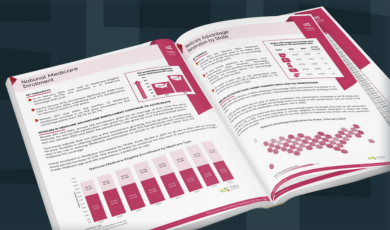Ashton Harrison, Marketing Engagement Manager
With a diverse background of sales and healthcare marketing, Ashton manages Trella’s events, press releases, and media and association relations. After graduating from Florida State University with a major in communications, she began her career at Greenway Health, a EHR company, where she found her passion for the healthcare industry. At Trella Health, she’s able to do all the things she loves about marketing — engaging at events, interactions with partners, and creating marketing pieces that share insight on Trella’s journey.6 Tips to Build a Successful Post-Acute Care Network – and Why You Should Care
By Ashton Harrison | August 25, 2021
Trella Health CEO Ian Juliano recently sat down with Dr. Eric Weaver of the Accountable Care Learning Collaborative (ACLC) for an episode of The Race to Value podcast to discuss how to build an effective post-acute network. Based on their conversation, we put together a few of Juliano’s best tips for ACOs, DCEs, and other organizations participating in the transition to value-based payment models.
The Challenge: Significant Variance in Post-Acute Costs
There’s an all-too-common problem facing ACOs and DCEs today. To avoid system leakage, hospitals almost exclusively refer patients to post-acute care facilities owned by their health system. While this may seem logical on the surface, it can have devastating effects on both cost and patient outcomes. Weaver pointed out that this phenomenon “can result in ineffective transitions of care and higher costs.” Further, with so much variance in costs across the post-acute care (PAC) continuum, it creates the perfect storm “for patients to stay too long in an inappropriate setting.”
This challenge is especially prevalent for less mature ACOs, which are, as Weaver puts it, “focused more on things like primary care access, [emergency department (ED)] diversion, and high-risk management.” Because these organizations have not yet been able to build effective strategies for optimizing their networks, they face significant challenges in ensuring that patients receive the appropriate post-acute care in the right settings.
Fortunately, this is not an insurmountable obstacle. ACOs – and especially less mature organizations still building out their networks – can benefit from strategic, data-driven approaches to network development. Especially when choosing their post-acute care affiliates.
1. Consider Cost Trajectory and Patient Outcomes
When asked about the significant cost variance in post-acute care, Juliano responded, “As a nation, we have been overly myopically focused on the cost of a post-acute setting versus the impact and the cost trajectory of the patient.” ACOs have taken on a certain amount of financial risk that didn’t exist under fee-for-service payment models. If they can consistently decrease costs while improving patient outcomes, they will reap the benefits of the shared savings program. If they cannot meet or exceed those benchmarks, though, they face potentially significant financial repercussions. This leads, as Juliano pointed out, to a more myopic view of post-discharge costs.
As a counter to this near-sighted approach, Juliano cites an example of one of Trella’s customers, “a large enterprise in South Carolina [that] reported using almost double the home health services that their competitor used. Yet, inclusive of that, they saved over $8,000 per patient, for a wide variety of higher severity diagnostic categories.”
Hospitals and health systems should consider patients ‘ cost trajectories instead of focusing solely on cutting costs by avoiding potentially costly post-acute settings. Once the patient has been stabilized in an acute setting, consider whether that patient should be discharged to home health, a skilled nursing facility, or hospice. Avoiding post-acute care because your organization is afraid of increasing costs will result in higher readmission rates and more costly care down the road. “Don’t just focus on the cost of post-acute settings,” Juliano implores, “Look at the return on your investment, and make smart decisions there.”
2. Identify Top Post-Acute Performers
While post-acute providers can significantly impact outcomes and reductions in cost, it’s still important to have a clear view of your network and which providers make the best-referring partners. The goal is always to ensure that patients receive the right care at the right time in the right setting. That means ACOs and health systems must be able to make informed decisions about where to discharge their acute patients.
Further, as you weigh the best care setting for post-acute patients, Juliano urges hospitals and physicians to consider the long term. “Identify, in various geographies, which post-acute providers are the best performers,” Juliano suggested, “Both in their own episode cost and in that long-term cost trajectory.”
Let’s say, for example, that you have a high-acuity circulatory patient with certain chronic comorbidities. Should you send them to a SNF or home health agency, and which one? With access to data on your post-acute partners and a focus on long-term cost trajectories, you can decide the best post-acute setting for the patient to control costs and improve outcomes.
3. Focus on Collaboration
Controlling costs is a group effort and an opportunity for collaboration. While you have multiple post-acute settings to choose from for your patients, those facilities and agencies may have limited capacity. So, while they can work to stand out as a preferred partner to you by focusing on key performance metrics, you can also stand out as a preferred partner to them by promising a steady stream of the right patients for their specializations.
By doing this, you can help your PAC affiliates serve the right patients for their settings. And, with open communication and a collaborative approach, you can educate them on the importance of access for your patients to their facility or agency, based on their performance in key areas. Let them know that you chose them for a reason. This can make a big difference for you and your PAC partners, as many of them are working hard to partner with solid referral sources.
4. It’s Not About a Narrower Network
With this in mind, you may be thinking that you should narrow your PAC network down to only a select few partners. That may not actually be the case, though. In Juliano’s words, “it’s not necessarily about narrowing the network. It’s about finding the right network that meets all of your specialized needs. To get the best in class for all of the different categories of patients that you have.”
There are essentially two typical approaches to network building. Many Medicare Advantage (MA) participants will cast a net so wide that it includes every possible provider in the area. On the other hand, ACOs tend to get laser-focused with incredibly narrow networks. We recommend a data-driven approach, where ACOs identify the best providers for their patient populations, ensure those providers are in their networks and develop strong relationships with them with clearly outlined expectations and goals for everyone involved.
5. Train Physicians to Help Patients Choose the Right Care Settings
For these strategies to work, ACOs need physician buy-in. “Physicians have so much influence over patient decisions about post-acute care,” Juliano points out. “When you show your physicians the data and explain to them why it is in the best interest of their patients to get that post-acute care and provide them guidance on where those patients should go – there’s still an aspect of patient choice, and we acknowledge that, but physicians have a huge influence on that.”
Consider the power of a physician positioning a post-acute recommendation as a choice between a higher-performing SNF versus a SNF with a 30% greater likelihood of the patient landing right back in the hospital within 30 days. In most instances, there’s no doubt at all – the patient will choose the higher-performing SNF. This is why it’s so important to look at the cost of post-acute care and the outcomes.
6. Invest in Data to Understand Performance
Finally, you cannot make these informed decisions without access to the right data. Juliano’s number one tip for ACOs is to “invest in understanding performance and put a huge priority on all of your partnerships.” This means investing in data and analytics for your organization, your competition, and your potential and existing post-acute partners and affiliates.
“I think this is a key element to breaking down silos and better coordinating care,” Juliano said. If ACOs invest in their people and data-focused technology, they’ll have the resources, structure, and education to improve outcomes, control costs, and improve performance in value-based payment models.
When you invest in people, you can educate physicians to refer patients to the right care settings for long-term positive outcomes and lower costs to patients and their families. Still, you cannot do that without a full view of the post-acute care ecosystem. With access to the right data, you can answer key questions to optimize your network. You’ll have a full view of important questions like:
- Are you identifying the right care needs and settings for your patients?
- Are you partnered with top-performing post-acute care providers?
- Can you accurately identify the best PAC partners in your network for specific patient needs?
If you can accurately answer these questions and you have optimal referral destinations for patients in need of post-acute care, you’ll have the tools and structure you need for an optimized PAC network that will help you drive down costs and improve patient outcomes across populations.
Next Steps: Accessing the Data ACOs Need for Optimized PAC Networks
For ACOs, success depends on improving care quality while reducing healthcare costs. To do this, you must reach or exceed multiple benchmarks for performance metrics. The tips in this article should help you develop a solid network to take advantage of the cost savings and improved outcomes that post-acute settings can provide your patients. But you cannot go in blind when you choose partners and affiliates for your network. A solid investment in data around the metrics that matter most to your network will help you avoid network leakage and drive down costs while improving care coordination and enhancing patient outcomes.
Check out a snippet of the recent podcast:
Access the full episode of ACLC’s Race to Value podcast.
Schedule a demo of Marketscape Strategy by Trella Health today to learn how to use complete Medicare and private payer claims data on 90% of the U.S. 65+ population to build a successful network and reap the benefits of a shared savings program.













